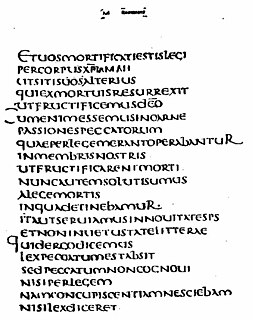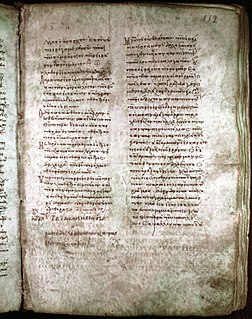| New Testament manuscript | |
| Text | 1 Corinthians 13:42 - 2 Corinthians 13:13 |
|---|---|
| Date | 10th century |
| Script | Greek |
| Now at | Biblioteca Marciana |
| Size | 32.5 cm by 24 cm |
| Type | Alexandrian text-type |
| Category | II |
Uncial 0243 (in the Gregory-Aland numbering), is a Greek uncial manuscript of the New Testament. Paleographically it has been assigned to the 10th century. [1]
The codex contains a part of the Pauline epistles, with text 1 Cor. 13:42 - 2 Cor. 13:13, on 7 parchment leaves (32.5 cm by 24 cm). The text is written in two columns per page, 48 lines per page, in uncial letters. [1]
The Second Epistle to the Corinthians is complete.
Currently it is dated by the INTF to the 10th century. [1] [2]
The manuscript was added to the list of the New Testament manuscripts by Kurt Aland in 1963. [3]
The Greek text of this codex is a representative of the Alexandrian text-type. Aland placed it in Category II. [1]
In 1 Corinthians 15:47 it reads δευτερος ανθρωπος along with א*, B, C, D, F, G, 33, 1739, it, vg, copbo eth. Other manuscripts read δευτερος ο κυριος (630, δευτερος ανθρωπος ο κυριος (אc, A, Dc, K, P, Ψ, 81, 104, 181, 326, 330, 436, 451, 614, 629, 1241, 1739mg, 1877, 1881, 1984, 1985, 2127, 2492, 2495, Byz, Lect), δευτερος ανθρωπος πνευματικος (𝔓46). [4]
In 1 Corinthians 15:54 it lacks το φθαρτον τουτο ενδυσηται αφθαρσιαν και along with 088, 0121a, 1175, 1739; [5]
In 2 Corinthians 11:14 it has reading ου θαυμα as have codices Sinaiticus, Vaticanus, Bezae, Augiensis, Boernerianus, Porphyrianus, Uncial 098, Minuscule 6, 33, 81, 326, 365, 630, 1175, 1739, 1881, 2464; the majority has the reading ου θαυμαστον (D2, Ψ, 0121a, Byz). [6]
Currently the codex is housed at the Biblioteca Marciana, 983 (II, 181) in Venice. [1]

Codex Claromontanus, symbolized by Dp, D2 or 06 (in the Gregory-Aland numbering), δ 1026 (von Soden), is a Greek-Latin diglot uncial manuscript of the New Testament, written in an uncial hand on vellum. The Greek and Latin texts are on facing pages, thus it is a "diglot" manuscript, like Codex Bezae Cantabrigiensis. The Latin text is designated by d (traditional system) or by 75 in Beuron system.

Codex Mosquensis I designated by Kap or 018, Απρ1 (Soden), is a Greek uncial manuscript of New Testament, palaeographically it has been assigned to the 9th century. The manuscript is lacunose.

Codex Porphyrianus designated by Papr or 025, α 3, is a Greek uncial manuscript of the Acts of Apostles, Pauline epistles, and General epistles, with some lacunae, dated paleographically to the 9th century. It is one of a few uncial manuscripts that include the Book of Revelation.
Codex Vaticanus Graecus 2061, usually known as Uncial 048, α1 (Soden), is a Greek uncial manuscript on parchment. It contains some parts of the New Testament, homilies of several authors, and Strabo's Geographica. Formerly it was known also as the Codex Basilianus 100, earlier as Codex Patriniensis 27. It was designated by ב a, p.
Uncial 049, α 2. It is a Greek uncial manuscript of the New Testament. Paleographically it has been assigned to the 9th century.

Minuscule 33, δ 48 (Soden), before the French Revolution was called Codex Colbertinus 2844. It is a Greek minuscule manuscript of the New Testament on parchment, dated palaeographically to the 9th century. The manuscript is lacunose. It has marginalia. According to the textual critics it is one of the best minuscule manuscripts of the New Testament.
Uncial 088, α 1021 (Soden), is a Greek uncial manuscript of the New Testament, dated paleographically to the 5th or 6th century.

Uncial 098, α 1025 (Soden), is a Greek uncial manuscript of the New Testament, dated palaeographically to the 7th-century. It is also named Codex Cryptoferratensis.

Uncial 0121a, α 1031 (Soden), is a Greek uncial manuscript of the New Testament, dated paleographically to the 10th-century.
Minuscule 81, or α162 is a Greek minuscule manuscript of the New Testament, on a parchment. It is dated by a colophon to the year 1044. Formerly it was labelled by 61a and 61p (Gregory). The manuscript is lacunose. It was adapted for liturgical use.

Uncial 0209, is a Greek uncial manuscript of the New Testament, dated palaeographically to the 7th-century.

Minuscule 1739, α 78, is a Greek minuscule manuscript of the New Testament, on 102 parchment leaves. It is dated paleographically to the 10th century.

Minuscule 104, α 103 (Soden), is a Greek minuscule manuscript of the New Testament, on parchment leaves. Palaeographically it has been assigned to the 11th century.
Minuscule 181, α 101 (Soden), is a Greek minuscule manuscript of the New Testament, on parchment. Palaeographically it has been assigned to the 11th century.
Minuscule 326, α 257 (Soden), is a Greek minuscule manuscript of the New Testament, on parchment. Paleographically it has been assigned to the 10th century. Formerly it was labelled by 33a and 39p . It was prepared for liturgical use.
Minuscule 365, δ 367 (Soden), is a Greek minuscule manuscript of the New Testament with some parts of the Old Testament, on parchment. Paleographically it has been assigned to the 12th century. It has marginalia.
Minuscule 451, α 178, is a Greek minuscule manuscript of the New Testament, on parchment. Palaeographically it has been assigned to the 11th century. Formerly it was labelled by 79a and 90p. The manuscript has not survived in complete condition.
Minuscule 630, α 461, is a Greek minuscule manuscript of the New Testament, on paper. It is known as Codex Ottobonianus. Palaeographically it has been assigned to the 12th or 13th century. The manuscript is lacunose. Formerly it was labeled by 163a and 201p.
Textual variants in the First Epistle to the Corinthians are the subject of the study called textual criticism of the New Testament. Textual variants in manuscripts arise when a copyist makes deliberate or inadvertent alterations to a text that is being reproduced. An abbreviated list of textual variants in this particular book is given in this article below.
Textual variants in the Second Epistle to the Corinthians are the subject of the study called textual criticism of the New Testament. Textual variants in manuscripts arise when a copyist makes deliberate or inadvertent alterations to a text that is being reproduced. An abbreviated list of textual variants in this particular book is given in this article below.